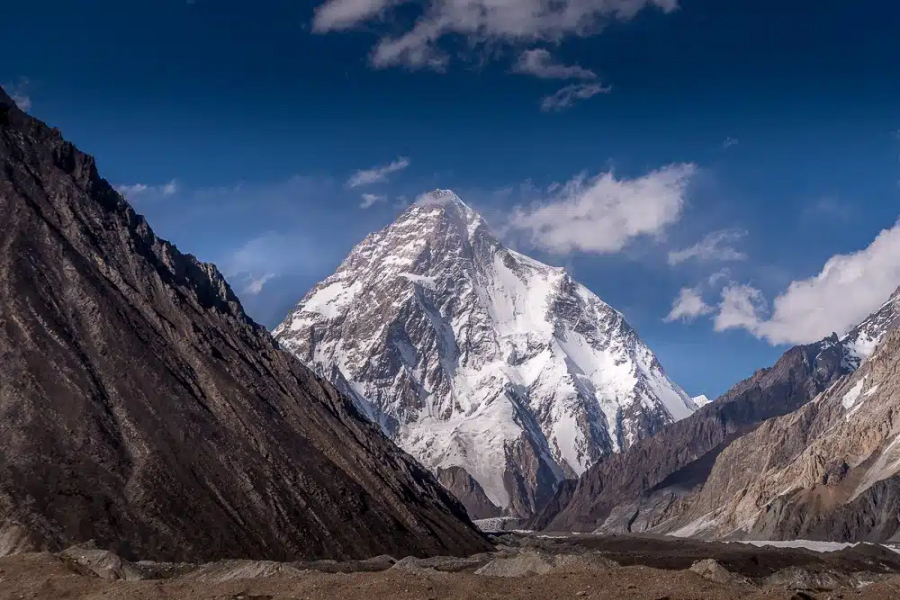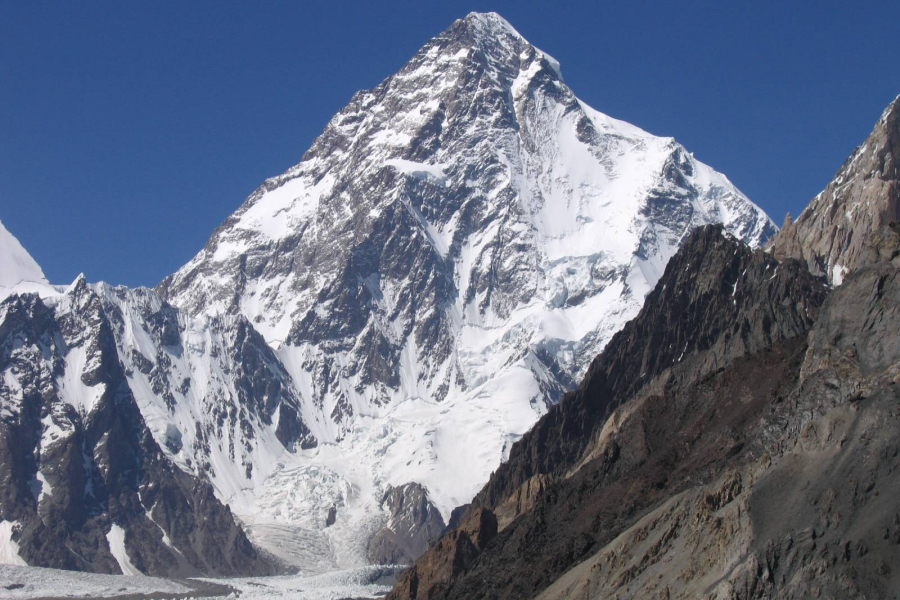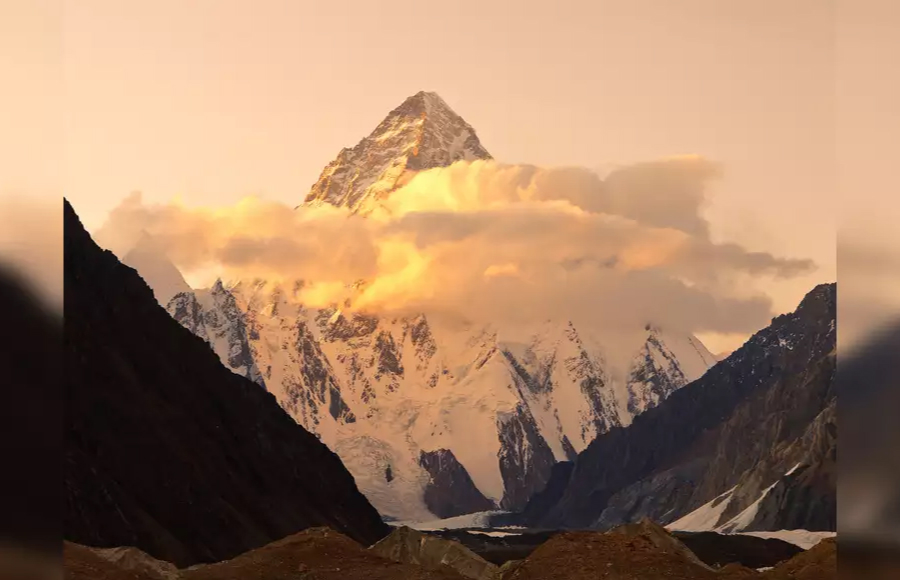Pakistan has 108 peaks over 7,000 metres high, with 4,555 peaks over 6,000 metres high. There is no official count of the peaks over 5,000 and 4,000 metres. Pakistan is home to five of the 14 highest independent peaks in the world, which are also known as the eight thousandths. Four of these peaks are located near Concordia, at the confluence of Baltoro Glacier and Godwin Austen Glacier. Most of Pakistan’s highest peaks are situated in the Karakoram mountain range, mainly in the Gilgit-Biltistan region, which is considered a separate range from the Himalayas. However, some peaks over 7,000 metres are in the Himalayan and Hindu Kush ranges. In addition to its towering peaks, Pakistan is home to over 7,000 glaciers, more than any other country except for the polar regions.

FAQS:
What is the highest peak in Pakistan?
The highest peak in Pakistan is K2, also known as Mount Godwin-Austen.
Which is the highest in Pakistan?
The highest peak in Pakistan is K2.
What is the highest peak in the world?
Mount Everest is the highest peak in the world, measured by its height above sea level. It is located in the Himalayas, on the border between Nepal and China.
Is K2 the tallest mountain?
No, K2 is not the tallest mountain when compared to its height above sea level. Mount Everest holds that distinction as the tallest mountain in the world. However, K2 is Pakistan’s second-highest mountain globally and its highest peak.
The Highest Peak of Pakistan:
Nestled in the heart of the Karakoram Range, the highest peak of Pakistan stands proudly as a testament to the country’s breathtaking natural beauty. K2, as it is commonly referred to, is the second-highest mountain in the world, also known as Mount Godwin-Austen. The hill attracts adventurers, mountaineers, and nature enthusiasts with its soaring elevation of 28,251 feet (8,611 meters) above sea level, making it a formidable challenge for anyone daring to attempt its ascent.
Towering peaks, icy glaciers, and breathtaking landscapes that depict Pakistan’s northern frontier are the hallmarks of K2’s majestic presence. Beyond its physical grandeur, K2 holds a rich history of expeditions, a testament to the indomitable human spirit and the allure of conquering nature’s towering giants. Discover your K2 adventure with our specialized “K2 Expedition” service.
The highest peak of Pakistan, K2, continues to beckon explorers, drawing them into the mystique of its formidable slopes and offering a glimpse into the raw, untouched beauty of the country’s mountainous heritage.

-
The History of K2 Expeditions:
K2, the second-highest mountain in the world, has attracted numerous expeditions since it was first surveyed in 1856. A British-led team that included the notorious occultist Aleister Crowley made the first serious attempt to climb K2 in 1902. However, after three unsuccessful American attempts in the 1930s and 1950s, an Italian team under the direction of Ardito Desio made the first successful ascent in 1954. Since then, K2 has been climbed through various routes, but it remains one of the world’s most challenging and dangerous peaks.
-
The Dangers of Climbing K2:
K2, the world’s second-highest mountain, is often called the “Savage Mountain” due to its high fatality rate and extreme difficulty. Climbing K2 is risky, with a mortality rate of 29 deaths for every 100 climbers who have successfully reached its summit. The dangers of climbing K2 include unpredictable weather, avalanches, rock falls, steep slopes, technical sections, a lack of oxygen, and human errors. Furthermore, the mountain is located in a remote area, limiting rescue options. The worst disaster on K2 occurred in 2008 when 11 climbers lost their lives in a series of accidents and avalanches.
-
The Best Time to Trek to K2 Base Camp:
The best time to trek to K2 Base Camp is between July and August, when the weather is more stable, and the skies are more likely, to be precise. However, the trekking season runs from mid-June to mid-September, so it is possible to trek anytime during those months. Travelling in early June or late September is not recommended because the snow has yet to melt or return, making the passes and glaciers more difficult and dangerous to cross. The trek to the K2 base camp takes about 14 days, a round trip, and starts in the village of Askole.
-
The Impact of Climate Change on K2’s Glaciers:
Climate change is becoming a significant concern for the glaciers in the Hindu Kush and Himalayan mountain ranges. These glaciers provide water to billions of people in Asia. However, the glaciers near K2 are an exception because they grow in size instead of shrinking. Researchers have discovered a unique circulation system of cold air called the “Karakoram vortex” that cools the region in summer and shields the glaciers from melting. How long this anomaly will last is still being determined, and the future of these glaciers remains uncertain.

The Second highest peak of Pakistan:
The second-highest peak in Pakistan is Nanga Parbat, often called the “Killer Mountain.” Standing at an imposing elevation of 8,126 meters (26,660 feet) above sea level, Nanga Parbat is part of the Himalayan range and is located in the Gilgit-Baltistan region. Renowned for its challenging and treacherous climbing conditions, the mountain has earned its ominous nickname due to the high fatality rate among those attempting to summit its peak. Despite its formidable reputation, Nanga Parbat attracts avid mountaineers and adventure enthusiasts from around the world who seek the thrill and prestige of conquering one of the most challenging peaks on the planet. The breathtaking beauty of the surrounding landscape and the sheer magnitude of Nanga Parbat contribute to its allure and make it a prominent feature in the majestic mountainous terrain of Pakistan. Discover your nanga parbat adventure with our specialized “Nanga Parbat Expedition” service.
Conclusion:
Pakistan’s mountainous landscape, with its staggering number of peaks over 7,000 meters, showcases a natural wonder that captivates adventurers and nature enthusiasts alike. Among these majestic peaks, K2, the second-highest mountain globally, symbolizes Pakistan’s breathtaking beauty and testament to the indomitable human spirit. Its soaring elevation and rich history of expeditions draw explorers into the mystique of its formidable slopes, offering a glimpse into the raw, untouched beauty of the country’s mountainous heritage.
As we delve into the history of K2 expeditions, we uncover the challenges climbers face on “Savage Mountain,” emphasizing the risks, dangers, and resilience required to conquer this towering giant. Despite its formidable reputation, K2 continues to beckon adventurers, highlighting its enduring allure.
Jasmine Tours, the premier tour agency in Pakistan, invites you to embark on an extraordinary journey to witness the grandeur of K2 and other remarkable peaks, including the second-highest, Nanga Parbat. Our service pages provide comprehensive information on tailor-made tours, expert-guided expeditions, and unforgettable experiences amidst these majestic mountains. Whether you are an intrepid mountaineer or a nature enthusiast, let Jasmine Tours be your gateway to the wonders of Pakistan’s mountainous treasures, promising an adventure of a lifetime amidst the raw beauty and challenges of K2 and Nanga Parbat.

